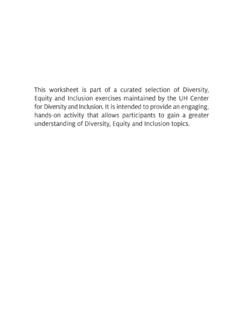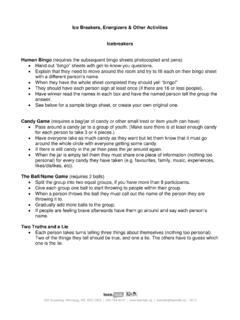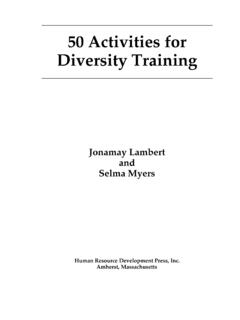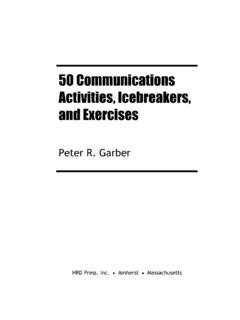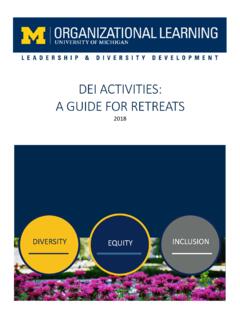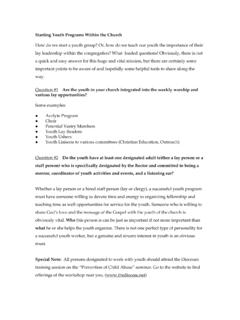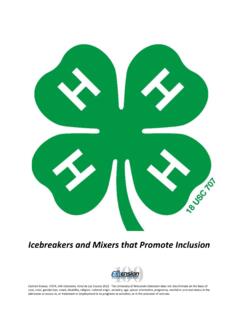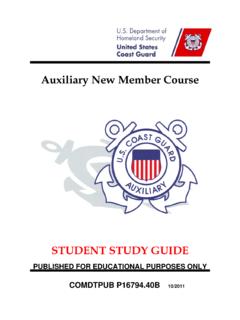Transcription of ICEBREAKERS GROUPS AND MENTAL HEALTH OH, MY
1 ICEBREAKERS , GROUPS AND. MENTAL HEALTH ! OH, MY! Brought to you by: The Nicasa Prevention Team ICE BREAKERS MAKE THINGS HAPPEN. An icebreaker is a special-purpose ship that is designed to navigate through dangerous ice covered waters. This is how the name ice breaking began to be applied to clearing the course for learning in a setting that could feel dangerously . uncomfortable as members don't know each other or know what to expect. can be used whether kids/people know each other or not. How did you get your name? BENEFITS OF ICEBREAKERS . 1. They are fun. Laughter is a positive thing! 2. Kids get involved quickly and more easily. 3. Barriers are broken.
2 4. People get to know each other or know more about each other. 5. Help clear out the cobwebs! 6. ICEBREAKERS create interaction that is nonthreatening. 7. They can instill confidence. 8. Opening up communication is key to success. 9. Creativity will improve. 10. New ideas will be generated. AND EVEN MORE BENEFITS . ICEBREAKERS create a rich learning atmosphere. They prepare kids to learn. ICEBREAKERS improve facilitation skills. They are good for you, too! They can make kids feel special. Motivating through activities can create more learning success down the road. Many learning styles can be used. Isolative participants can engage more easily. ICEBREAKERS make commonalities more evident.
3 Out of the box thinking is a life tool. And now it's time for M&Ms ICEBREAKERS are great because they can be used in all settings and across the lifespan. FOR CREATING THE RIGHT KIND OF ICEBREAKER. Plan ahead, make a good choice and practice. Have supplies ready. Allow sufficient time for completion and processing. Process everything. Relax! and have fun. Reduce complex instructions. Monitor what happens. Don't repeat it. Have a back up plan. If it doesn't work, don't blame process it! AND NOW THE FOR ICEBREAKERS . forget to gauge who is in your group assume they must occur only at the beginning of group/activity force participation . ask yourself; what does participation look like?
4 Provide painful feedback .this may be setting a tone for group interest. occur too many times without variety . no direct relevance lack of preparation or going in cold . WHAT'S. awesome?? AND FINALLY: Carefully crafted, ICEBREAKERS can be very powerful. Create a fun atmosphere for learning and help people retain information. TIME FOR. GROUP! ESSENTIALS FOR UNDERSTANDING. AND FACILITATING GROUPS . Observe with eyes that honor people. Know that poor behavior might be a math problem: Frustrations > Skills Priorities, attitudes and goals can become more evident because of the group experience. ATTRIBUTES OF FACILITATORS. Open Honest Fair Consistent Focused Active listeners Accessible Flexible Assertive Enthusiastic Adaptive Proactive Responsive Resilient Group Size?
5 What is your ? The more you understand yourself the better you are able to understand what motivates others. Go in cold or plan? How? When? are the expected rules of conduct that are important for the group's full participation and success. Four walls behavior Control what you can promote participation A FEW KEY DON'TS .JUST DON'T DO IT! Be afraid of disagreement Allow one person to dominate Let one point of view override the group Assume because of background, environment or culture Be the font of all wisdom Disclose your past as an adolescent Food or no food? Rewards or no rewards? ACTIVE LISTENING AND BRAINSTORMING. Active Listening Expresses understanding Statesthe problem Brainstorming Generatesnew ideas Uses knowledge of the group THE MOST THERAPEUTIC MATERIALS ON.
6 THE PLANET (NO KIDDING): Legos The Box o'Crap Uno GROUP BEHAVIOR GOALS. Be fully present Be responsible for your own needs Listen and respond Take risks Lean into discomfort Accept conflict as a catalyst Be open-minded Honor confidentiality Accept diversity Decide what participation looks like Behavior, Grades and Relationships COMMON SITUATIONS WHERE. YOU MAY NEED TO INTERVENE. Side bars On time Never ending discussions lnternal conflict Process EVERYTHING! RESILIENCY MODEL. Problem solving Sense of future Sense of humor Social competence Mentor Model what you want to see. Control your own biases Predict what you want to see. Ensure self care and co-facilitator care.
7 Closing your group with a feedback You will have an impact on every person you come in contact with either by design or by default. Which do you choose? Abuse of Physical alcohol/ complaints Depression drugs Self-injury/. Cutting Threats to Intense fear run away of becoming Aggression Frequent obese outbursts Nightmares Inability to cope Marked change in school Threat to performance harm self Sexual or others acting out Unusual behavior At least 1 in 5. children and adolescents has a MENTAL HEALTH disorder 1 in 10 has a serious disorder 90% of people who develop a MENTAL disorder show warning signs during their teen years For the most part children can develop the same MENTAL HEALTH conditions as adults, but their symptoms may be different.
8 SOME KIDS DON'T GET HELP. BECAUSE . Many MENTAL illnesses may look like typical adolescent behavior Stigma is alive and living in your neighborhood Families don't know about available treatment Kids may not have the vocabulary to tell us that something is wrong Families may be afraid of medication SOME ILLNESSSES THAT AFFECT KIDS ARE: Anxiety disorders ADD/ADHD. Autism Spectrum Disorders Eating Disorders Mood disorders Schizophrenia Substance Use Disorders Behavioral Disorders Non Suicidal Self-injury CLINICAL DEPRESSION. Deep despair, sadness, crying 1 in 13 teens experience symptoms BIPOLAR DISORDER. Extreme changes from happy to sad 1 in 100 teens have it Hard to diagnose, looks like depression ANXIETY DISORDERS.
9 Overwhelming fear with no cause Risk is greater with family history EATING DISORDERS. Unrealistic thoughts about weight 1 in 20 teens suffer; 90% females Untreated it can result in hospitalization or death SCHIZOPHRENIA. Strange thoughts, unusual behaviors High functioning, then big decline Distrustful, no longer social, voices ADHD. Problems paying attention Can seriously impact ability to learn OPPOSITIONAL DEFIANT. DISORDER. Stubborn, argumentative, hostile Major distraction in the classroom CONDUCT DISORDER. Verbal/physical aggression Junior sociopaths End up in detention centers WATCH OUT FOR: Sadness, withdrawal, moodiness Intensity in feelings or anxiety Anger or risk taking Talking about suicide, subtle talk as well Difficulty concentrating Weight loss Changes in appearance Bruising, cuts.
10 Changes in how clothing is worn Change in peers Physical symptoms A SHAMELESS PLUG FOR: Assess for risk of suicide or harm ( What is your approach?). Listen nonjudgmentally Give reassurance and information Encourage appropriate professional help Encourage self-help and other support strategies KEY UNDERSTANDINGS: What is your role and what does your role allow? What do you know about your community for professional help and self-help? Are you prepared for a MENTAL HEALTH issue? Do you have an agency protocol? Change Weirdness Inexperience Self-consciousness Risk Taking Steps YOU Can Take NOTICE TALK ACT. Adolescence is like having only enough light to see the step directly in front of you.

